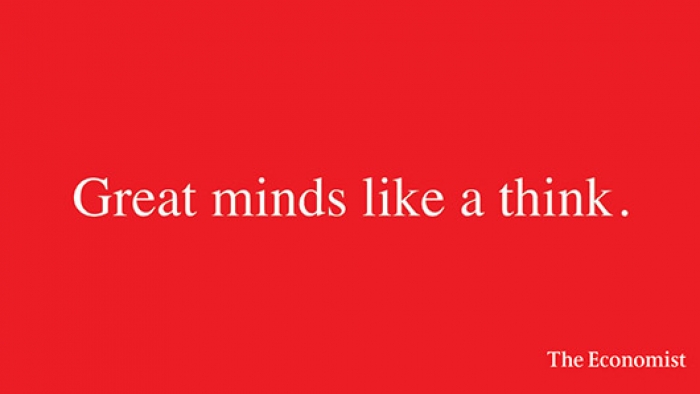Posted by Nixon
Tools pinched from other places keep your writing fresh, and copywriting, more than any other medium, is a hybrid of styles. We’ve learnt from storytelling before, but what about poetry – can it teach us anything useful?
It sure can. The techniques poets employ charge their words with music and emotion, which makes them compelling, memorable and effective. Let’s look at some of these techniques and see how we can apply them to copy for cracking results.
Brevity
A key feature of most poetry (no one mention the word ‘epic’) is its concision: meaning, experience and ideas are distilled into a potent reduction. For instance, here’s Ezra Pound’s poem ‘In a Station of the Metro’:

Pound edited this poem down from 30 lines to 14 words, ruthlessly discarding anything superfluous. The result is a poem that cuts to the quick, and is much closer to Pound’s subject and experience than a 30-line poem would be.
From a marketing perspective, concise copy is more enticing and easier to read. I doubt anyone would skip past Pound’s poem as it stands, but if I’d posted a 30-liner it’d be a different story. The crisper your copy, the more likely your audience is to read it all and the sharper your message will be.
These ads from The Economist are a prime example:


The messaging is so succinct that you finish reading the adverts as soon as you see them: the design catches the eye and the concision ensures that the copy gets read. In fact, each enigmatic one-liner is so concise that it needs some interpretation, which embodies The Economist’s offer far more effectively than a sales pitch.
To make your writing more concise, do what Pound did: edit. Cut back your content until you can’t cut any more. And if your audience, brand and brief allow it, hold back just enough to make your reader work for the meaning.
Precision
Brevity demands precision: if you’re limiting your words you need to choose the right ones. Think about associations and look up alternatives, and avoid wafty marketing buzzwords. By really considering your word choice, you’ll start to think more deeply about what you’re trying to convey and the nuances of language.
But keep your tone of voice in mind and don’t get carried away with the thesaurus: if a simple word works, it works. Here’s some wise advice of T.S. Eliot’s from his poem ‘Little Gidding’:

It’s not only your language that should be exact: your whole message needs to be quick and to the point. Apple is a master of precise copywriting. This bit of copy from their website hints at the iPad’s appeal, as well as Apple’s wider brand proposition, with two clear-cut, contradictory statements:

No waffling here. It’s as though they thought, ‘What’s the message we want to communicate?’ and used the punchiest answer word for word, rather than writing copy around it. The language is plain, the point is precise, and, best of all, there’s not a marketing buzzword in sight.
Rhythm
In language, especially poetry, the prosody – i.e. patterns of rhythm and sound – is often as important as the meaning behind the words. Sound comes from the words themselves (which we’ll look at a little later) and rhythm comes from the way you structure them. Rhythm is the heartbeat of your text: it keeps your reader rolling through the sentences, adds musicality and emphasises certain words; it gives it life.
Consider these lines from ‘After Death’ by Christina Rossetti:

Read them aloud and feel how the poem gently pushes forward. There’s a kind of pleasing monotony in the (technical term alert) iambic pentameter, i.e. the rhythm that goes: di-dum di-dum di-dum di-dum di-dum*; it leads you through the poem yet creates a sense of stillness, with a creeping lattice-like pattern. Its metrical precision also makes the speaker’s voice sound detached and unemotional.
*The first line varies this with a minor ionic foot (di-di-dum-dum) thrown in, but this doesn’t disrupt the overall iambic rhythm.
See how the rhythm shapes the tone of the poem, without even considering the language? It’s the same in any form of writing, including copy.
Read the previous sentence aloud. Can you hear how it speeds up with ‘in any form of writing’, pauses with the comma, then finishes with a slow, balanced di-dum di-dum di, giving it a natural sense of closure? Rhythm can slow down or speed up the reading process, alter the tone of the text and generally make it more pleasing to read. It’s great for short and long copy alike, as it can make a strapline stick in someone’s mind and keep a reader chugging forward from sentence to sentence.
Here’s a well-known slogan:

Can you hear the rhythm? What if we change some words, such as ‘Every bit helps’ or ‘Every little bit helps’. Doesn’t have the same ring, does it? And it’s precisely the ring, or the rhythm, that makes the slogan work. That’s why we’ll often push back when a client wants to insert one word here or tack on a clause there: the smallest change to a sentence can disrupt its entire rhythm, which sends ripples through the rest of the paragraph.
Making your writing flow is hard to master – sometimes it’s tough enough just to put your ideas down on paper, let alone make them rhythmic. I’d suggest working on the rhythm in the editing stage. Read what you’ve written aloud and listen for patterns. Pay attention to the accents and syllables. Are there places you naturally pause? Does your tongue trip up anywhere? Make little tweaks until the rhythm pervades the text with invisible energy – you want it to be unnoticeably natural, yet pull the reader along.
Alliteration, assonance and near rhymes
There are various other ways that sound affects the meaning and tone of a text, such as alliteration, assonance and half-rhymes. Alliteration is when two or more words close together begin with the same letter or sound, as in ‘content is queen’. Assonance is a little looser: it’s when nearby words share similar sounds, particularly rhyming vowels, such as ‘candle’ and ‘mantle’, and identical consonants, such as ‘light’ and ‘late’ (also known as pararhymes). Half-rhymes are, as you can guess, words that almost rhyme and have similar consonant sounds, such as ‘bridge’ and ‘grudge’.
Joyce Carol Oates uses assonance and half-rhyme in her poem ‘The First Room’:

The half-rhyme of ‘dream’ and ‘room’ and the assonance of the elongated oo sounds create a sense of something pushing, protruding (I picture the Demogorgon from Stranger Things stretching the walls like rubber, or Ace Ventura birthed by a robot rhino). The double T in ‘matter’ and the ‘-ten’ and ‘-ton’ create a kind of clattering noise, like the clacking of bones, which then pierces the room’s stretching walls with the final word ‘protrudes’ (run, Winona).
When writing copy, you don’t have to think in this much depth. Alliteration, assonance and half-rhymes simply create patterns that are pleasing to the reader’s inner ear.
If you want to be a bit more advanced, consider the effects of particular sounds: Ls create a lolling, languorous tone and Ps pack a punch (notice how in these examples, the rhythm works to accentuate the effects of the sounds). These techniques are best used sparingly, though. Some subtle alliteration, assonance and near rhymes can warm a reader to the text; too much and it becomes a gimmick.
Rhyme
Just as alliteration and assonance are most effective when they’re subtle, rhyme should be a rarity – a little glint to treat the attentive reader and draw the inattentive reader back into the text. It also works well in headlines, slogans and ad campaigns as it’s catchy and memorable. And when used at the end of a passage, it creates closure by neatly tying the text with a bow. That’s why the English sonnet ends with a rhyming couplet – to bring the poem to a strong resolution.
Let’s look at an English sonnet, from the master of the form: Shakespeare’s ‘Sonnet 104: To me, fair friend, you never can be old’. Rather than clip a few lines, let’s look at this one in full. Take a few moments to read it, reread it and speak it out loud:

That final couplet: it’s like a punch in the solar plexus, right? I don’t think we need to dwell too much on the effect of rhyme here. I’m sure we can all feel it’s doing something important.
So how does rhyme work in copy? Here’s a strapline our lead content strategist, Megan, wrote for Latitude50:

It’s simple, it’s clear and it’s catchy. Rhythmically it rises like a wave, and the sibilance sounds like the sea brushing the shore. But its obvious quality is the rhyme, which accentuates the way the rhythm builds. More importantly, the rhyme makes the strapline stand out; it makes it memorable.
The envoi
So what have we learnt? Much, hopefully. You can see that with good copy, as with good poetry, a lot of stuff’s happening under the surface. All of the things we’ve covered – brevity, precision, rhythm, sounds and rhyme – can be achieved during the editing process. Get your words out, trim them down and tweak them till they sing. And if you want to be a better copywriter, or writer in general, do what we’ve done here: pick apart the best examples to figure out why they work. Look beyond the language: consider how the sounds, the pace and the structure all affect you as a reader, then try to emulate those techniques.
Liked this? We’ve got plenty of other posts offering copywriting tips, including Why context is important and How to beat writer’s block.
And if you need a professional writer to craft creative, compelling copy, check out our content strategy services and see what we can do for you.
Special thanks to the Poetry Foundation for publishing a wealth of contemporary and classic poems online for everyone to read.
Guest blogger Samuel Birnie is a writer and former content strategist at Nixon Design; he's currently training to be a teacher.

